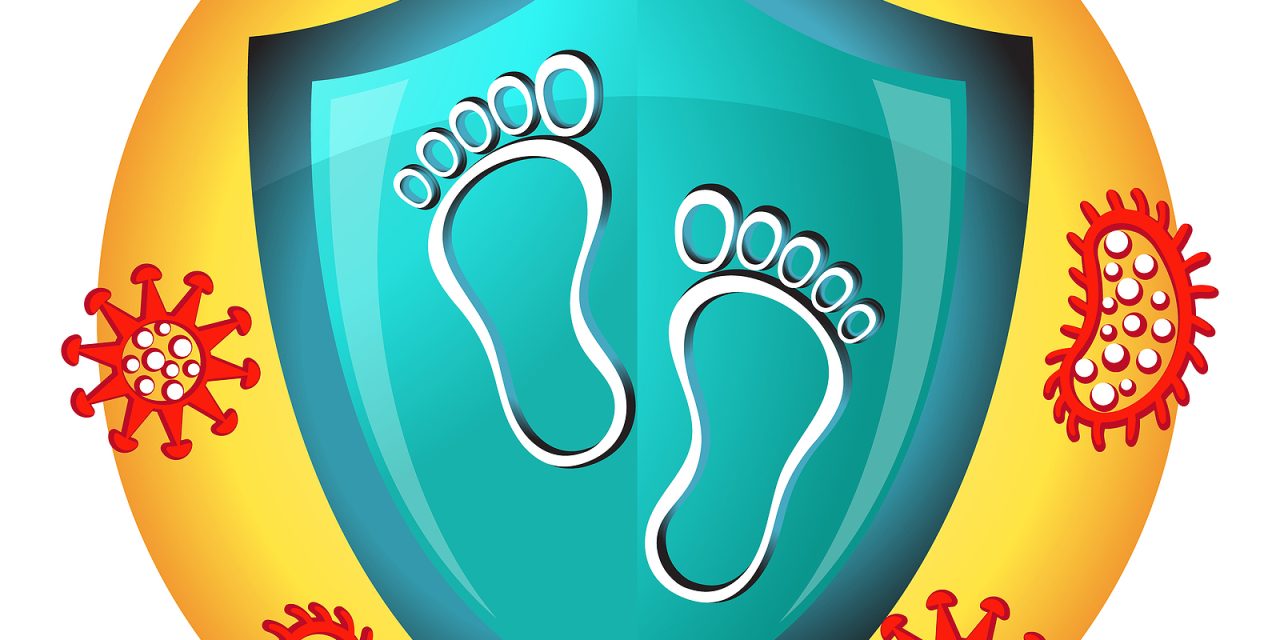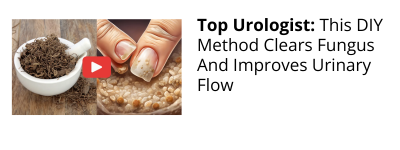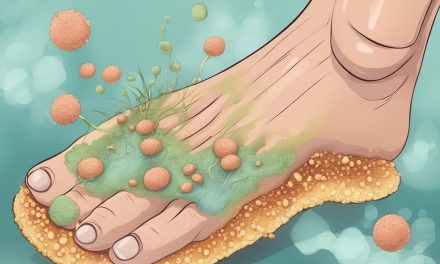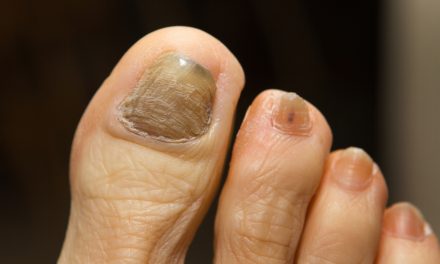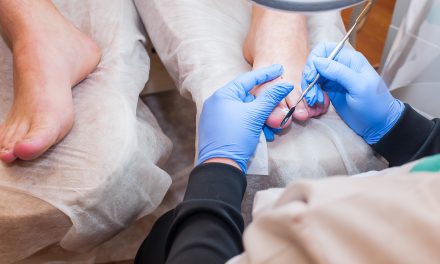Toenail fungus is a common condition scientifically known as onychomycosis. It’s characterized by thickening, discoloration, and sometimes an unpleasant odor of the affected nails. The fungus thrives in warm, moist environments, making toenails a particularly vulnerable site for infection. This condition can cause discomfort, pain, and embarrassment. While commonly affecting toenails, it can also spread to fingernails and even skin.

The spread of toenail fungus typically occurs through direct contact or through environments where the fungus is present, such as gyms, showers, or swimming pools. Treatments range from over-the-counter antifungal medications to prescription drugs, topical treatments, and in some cases, surgical removal of the nail. Prevention methods include maintaining good foot hygiene, keeping nails trimmed, and avoiding walking barefoot in public places. It is advisable to consult a healthcare professional if over-the-counter treatments do not lead to improvement or if the infection seems to worsen.
Key Takeaways
- Toenail fungus, or onychomycosis, manifests as discolored, thickened nails and can spread to other nails or skin.
- Treatment options vary, including antifungal medications and, in severe cases, nail removal.
- Preventative measures are essential for avoiding the spread of the fungus and include maintaining foot hygiene and proper nail care.
Understanding Toenail Fungus
Toenail fungus, or onychomycosis, is a common condition that can lead to discoloration and thickening of the toenails. Knowledge of its causes, symptoms, and associated risk factors is essential for effective management and treatment.
What Is Toenail Fungus?
Toenail fungus, medically known as onychomycosis, involves the infection of the toenails by a type of fungi known as dermatophytes. This condition can cause the nails to become dark, discolored, and thickened. While the fungal infection primarily affects toenails, in some cases, it may also impact fingernails.
Causes and Risk Factors
The development of toenail fungus often results from the growth of fungi in, under, or on the nail. Conditions that foster this environment include:
- Moisture: Prolonged exposure to moist environments, such as sweaty shoes or showers.
- Age: Incidence increases with age due to slower nail growth and reduced blood flow.
- Compromised Immune System: Individuals with weakened immune responses may be more susceptible.
- Diabetes: Can lead to reduced blood flow to the extremities, thereby increasing the risk.
Signs and Symptoms
Signs of toenail fungus include nails that are:
- Thickened: Noticeable increase in nail thickness.
- Brittle, crumbly or ragged: Change in nail texture.
- Discolored: Nails may turn yellowish, brownish or have white patches.
- Slightly foul-smelling: Fungal infection may emit an odor.
Recognizing these symptoms early can assist in preventing the spread of toenail fungus and guiding effective treatment options.
Diagnosis of Toenail Fungus
Accurate diagnosis of toenail fungus is essential for effective treatment. It often starts as a white or yellow spot under the tip of the toenail. As the infection goes deeper, it may cause the nail to discolor, thicken, and crumble at the edge.
Professional Diagnosis
When one suspects a fungal nail infection, a healthcare professional can provide a definitive diagnosis. The diagnosis process typically involves a thorough examination of the nails. A sample of the nail or debris from under the nail may be collected and sent to a laboratory to identify the type of fungi causing the infection. This helps in determining the appropriate course of treatment. Diagnosis by a professional is crucial to rule out other conditions that can mimic fungal infections, such as psoriasis.
Self-Examination Tips
Individuals can perform a preliminary self-examination to look for signs of a toenail fungal infection before seeing a healthcare provider. Key things to look for include:
- A white or yellow spot under the tip of the nail.
- Brittle, crumbly, or ragged nails.
- Nails that are separated from the nail bed.
- Thickening of the nails.
- Build-up of debris under the nail.
If these symptoms are present and persistent, and especially if they are accompanied by pain or discomfort, one should consult a healthcare provider for a professional diagnosis. A self-examination should not replace professional medical advice.
Treatment Options
When combating toenail fungus, there are multiple treatment avenues that individuals can pursue. These range from over-the-counter solutions to prescription medications and advanced therapies designed to eradicate fungal infections.
Over-the-Counter Treatments
Over-the-counter treatments typically include antifungal creams or solutions that can be applied directly to the affected area. One common treatment is the use of antifungal nail polish such as ciclopirox, which is painted on the infected nails and surrounding skin. Another option is over-the-counter antifungal creams which can assist in controlling the fungus when applied consistently.
Prescription Medications
For more persistent cases of toenail fungus, prescription medication might be necessary. Oral medications like terbinafine (often known by the brand name Lamisil) and itraconazole are potent antifungals that can help clear the infection by targeting the fungus from within. These treatments require a doctor’s prescription and can come with side effects, so it is important to discuss these options with a healthcare provider.
Advanced Therapies
In severe or resistant cases of toenail fungus, advanced therapies may be recommended. Laser treatment is a modern technique that involves targeting the fungus with laser energy, disrupting the growth and viability of the fungal cells. Additionally, a prescription medication called Jublia is available as a topical solution, specifically designed to treat toenail fungus with a unique method of application. These advanced treatments are often considered after other therapies have failed to produce desirable results.
Natural Remedies
To combat toenail fungus naturally, one might consider herbal and essential oils known for their antifungal properties or home treatment options that utilize everyday household items. These methods focus on inhibiting the growth of the fungus and improving nail health.
Herbal and Essential Oils
- Tea Tree Oil: Widely recognized for its antifungal and antiseptic abilities, tea tree oil can be applied directly to the affected nail to help treat toenail fungus. It is recommended to dilute it with a carrier oil to reduce potential skin irritation.
- Eucalyptus Oil: Found in products like Vicks VapoRub, eucalyptus oil’s antifungal properties may improve toenail fungus when applied topically.
- Snakeroot Extract: Extracted from plants of the sunflower family, snakeroot extract is another topical remedy believed to be effective against toenail fungus.
Home Treatment Options
- Menthol: Known for its cooling sensation, menthol is another ingredient in Vicks VapoRub which may help alleviate symptoms related to toenail fungus.
- Garlic: Often used for its medicinal properties, garlic has shown antifungal effects which may be beneficial when crushed and applied to fungal-affected toenails. However, its effectiveness as a treatment for toenail fungus isn’t as well established as more traditional remedies.
Preventing Toenail Fungus
Effective prevention of toenail fungus involves maintaining good foot hygiene and taking protective steps to avoid contact with fungi. The key is to create an environment where fungi are less likely to thrive and infect your toenails.
Lifestyle and Hygiene
Daily foot care is crucial for preventing toenail fungus. Keeping feet clean, dry, and well-groomed minimizes the risk of infection. One should always wash and thoroughly dry their feet, paying special attention to the areas between the toes where moisture can accumulate. Using antifungal powders or sprays can help keep the feet dry and less hospitable to fungal growth. Additionally, regularly trimming nails straight across prevents them from growing into the skin and becoming an entry point for fungi.
- Ways to Maintain Foot Hygiene:
- Wash feet with soap and water daily.
- Dry feet completely after washing, particularly between the toes.
- Apply antifungal foot powder or spray routinely.
- Trim toenails regularly to keep them short and avoid accumulation of dirt and debris.
Protective Measures
One of the primary modes of transmission for toenail fungus is through direct contact with contaminated surfaces. It’s important to wear shoes while walking in damp communal areas, such as swimming pools, gyms, and shower rooms, to prevent exposure. Additionally, when choosing footwear, opt for breathable materials to reduce moisture buildup. For those who enjoy getting pedicures, going to salons that properly sterilize their equipment can decrease the risk of acquiring toenail fungus. Using a personal set of tools for pedicures at home or at the salon is also a proactive step.
- Tips for Protective Footwear and Behavior:
- Always wear footwear in public pools and locker rooms.
- Select shoes made from materials that allow feet to breathe.
- Ensure salons sterilize pedicure tools before usage or bring your own set.
By adopting rigorous hygiene routines and protective behaviors, individuals can significantly reduce their chances of developing toenail fungus.
Potential Complications
Toenail fungus, if ignored, can lead to several health consequences beyond the nail itself. Understanding the inherent risks and recognizing when to seek medical intervention are crucial for maintaining foot health and preventing further complications.
Understanding the Risks
Fungal infection can be more than just an aesthetic issue. If left untreated, it may cause nails to become thick, brittle, and possibly painful, which might interfere with standing, walking, or exercising. Individuals with a weakened immune system, including those with HIV or other conditions that compromise immunity, are more susceptible to the spread and exacerbation of toenail fungus. The risk of reinfection or spreading the infection to other parts of the body is a concern and can result in more severe systemic issues.
When to Seek Further Care
It is imperative to consult a healthcare provider if toenail fungus persists or if there are signs of a worsening condition. This includes spreading of the infection beyond the toe, increased pain, swelling, or if the affected individual has diabetes or a weakened immune system. The latter conditions can lead to a higher risk of bacterial skin infections and further complications that can have significant implications if left unaddressed.
Special Considerations
When managing toenail fungus, certain factors such as existing chronic conditions or age can necessitate special considerations to effectively treat and prevent recurrence of the infection.
Dealing with Chronic Conditions
For individuals with chronic conditions like diabetes or an immune system compromised by illnesses such as HIV, the risk of toenail fungus may be elevated, and its treatment can be more complex. Those with diabetes must be vigilant as they are prone to infections due to often reduced blood circulation to the feet. Regular monitoring and maintaining blood sugar levels can be crucial in preventing infections. In cases where the immune system is weakened, such as with HIV, the body’s ability to fight off fungal infections is impaired. Thus, a proactive approach to treatment, involving antifungal medications and consistent foot care, is important to manage symptoms and prevent spread.
Age-Related Concerns
As individuals age, their nails can become more brittle and prone to damage, which can create an entryway for fungi. The effectiveness of the immune system also diminishes over time, making infections including toenail fungus more likely. Additionally, conditions like psoriasis can manifest more frequently in older adults, potentially complicating the diagnosis and treatment of toenail fungus as symptoms may overlap. It is essential for older adults to maintain foot hygiene, promptly address any nail injuries, and seek medical advice when changes in nail appearance occur to ensure timely treatment.
Cosmetic and Daily Care
In the context of toenail fungus, certain cosmetics and routine care practices can play a significant role in both the appearance and management of affected nails.
Nail Polishes and Cosmetics
Medicated nail polishes form a cornerstone in the cosmetic management of toenail fungus. These specialized polishes not only conceal discoloration but also contain antifungal agents that help suppress fungal growth. A prescription polish may be obtained from a healthcare provider, which assists in combating the fungus while improving the nail’s appearance. It is critical, however, to ensure that cosmetic products used do not exacerbate the condition; thus, individuals should opt for products explicitly designed for fungal conditions.
Daily Nail Care
Regarding daily nail care, maintaining short, neatly filed nails is imperative. A clean file should be used to gently smooth out any rough edges, thus preventing snagging and additional trauma to the nail. Tools used must be sanitized between uses to eliminate any chance of spreading the infection. Additionally, keeping the nails clean and dry wards off an environment conducive to fungal growth. Moisture management can be further aided by wearing breathable footwear and moisture-wicking socks.
Understanding Contagion
Toenail fungus is not only persistent but also contagious, capable of spreading through various channels, including direct contact and shared surfaces. Knowing how this infection is transmitted and the ways to minimize its spread is crucial for both personal health and public safety.
How Toenail Fungus Spreads
Toenail fungus, known scientifically as onychomycosis, often spreads through direct contact with an infected individual’s nails. Shared environments like showers, locker rooms, and pools are common places where fungi such as dermatophytes—which cause conditions like athlete’s foot, ringworm, jock itch, and scalp infections—lurk on surfaces, waiting to infect a new host. These fungi thrive in moist, warm environments, making such communal areas hotbeds for transmission.
Minimizing Spread to Others
To minimize the contagiousness of toenail fungus, individuals should:
- Maintain good foot hygiene by regular washing and drying of feet.
- Avoid walking barefoot in public areas and opt for footwear like flip-flops in communal showers or pools.
- Disinfect personal grooming tools and avoid sharing them.
- Seek prompt treatment for athlete’s foot to prevent spread to the nails.
- Change socks and shoes regularly to keep feet dry, which is less conducive to fungal growth.
By diligently following these steps, the risk of spreading toenail fungus can be significantly reduced.
When to Consult a Professional
When dealing with toenail fungus, understanding when to seek medical guidance is crucial. A healthcare professional can offer an accurate diagnosis, assess the severity, and potentially prescribe medications.
Assessing Severity and Complications
One should consult a professional when toenail fungus symptoms intensify or complications arise. Here are specific indications:
- Increased Pain or Discomfort: If the affected area becomes painful or causes discomfort when walking or wearing shoes, it may be time to see a doctor.
- Suspected Bacterial Infection: Signs of infection, such as redness, swelling, or pus, indicate the need for professional assessment.
- Pre-existing Health Conditions: Those with diabetes or a weakened immune system are more prone to complications and should consult a doctor early on.
Understanding Treatment Limitations
Understanding the limitations of over-the-counter treatments is important. Factors influencing the decision to consult a professional include:
- Ineffectiveness of Home Treatments: When over-the-counter remedies provide no relief, a doctor may prescribe stronger medications, like oral antifungals or topical agents.
- Location and Severity: Fingernail fungus often responds quicker to treatment compared to toenail fungus due to faster growth rates. Prescription medications might be necessary for severe cases or when the fungus is located beneath the nail.
- Side Effects and Drug Interactions: Oral antifungals are powerful and can interact with other medications. A doctor can assess the safety and suitability of these drugs for your situation.
Frequently Asked Questions
Toenail fungus, also known as onychomycosis, is both a common and treatable condition with specific methods that can effectively address it. As one navigates the various treatments and preventive measures, it is crucial to understand what to expect during the healing process and the potential risks of leaving the condition unaddressed.
What methods are proven to kill toenail fungus effectively and swiftly?
Topical antifungal treatments and oral medications are often prescribed to address toenail fungus, with patients seeing a [noticeable improvement
Is there a potential for toenail fungus to become life-threatening?
Toenail fungus is usually not life-threatening. However, it may lead to serious complications for individuals with weakened immune systems or those with diabetes, causing further foot problems.
What signs indicate that toenail fungus is healing or has died?
One can observe that toenail fungus is healing when there is a reduction in discoloration and thickness of the nail, and new, healthy nail growth is present at the base of the nail.
How can I prevent the spread of toenail fungus to other nails or skin?
Preventing the spread can be achieved by maintaining good foot hygiene, ensuring feet and nails are clean and dry, avoiding shared footwear, and using antifungal powders or sprays as a preventive measure.
What are the consequences if toenail fungus is not treated and begins to spread?
Untreated toenail fungus can lead to thickened and misshapen nails, which may become painful. Chronic infection can also potentially spread beyond the nail, leading to skin infections or, in severe cases, cellulitis.
Is it possible to completely eliminate toenail fungus, and if so, how?
Complete elimination is possible with consistent treatment, which may include oral and topical medications. However, it is essential to understand that treatment can be lengthy, often taking several months, as toenails grow slowly and treatment depends on the severity of the infection.

